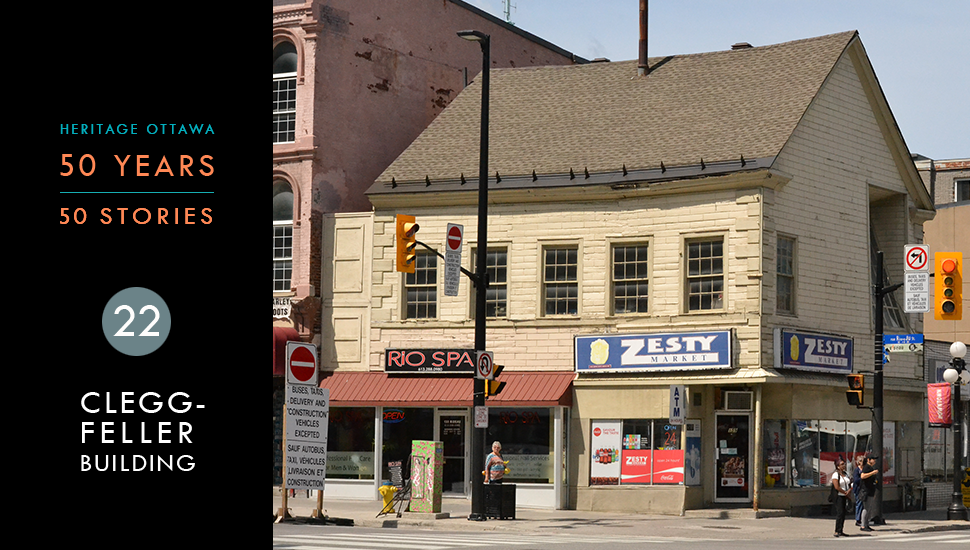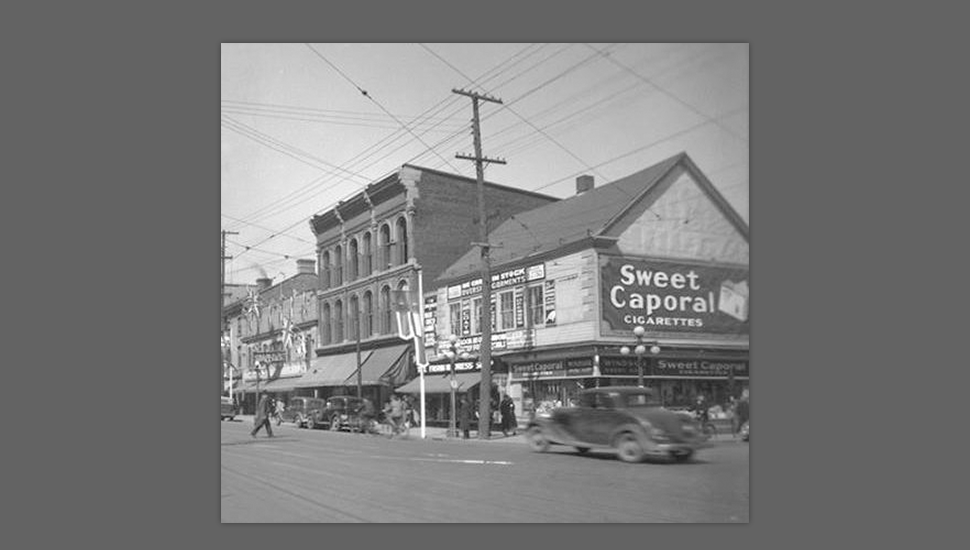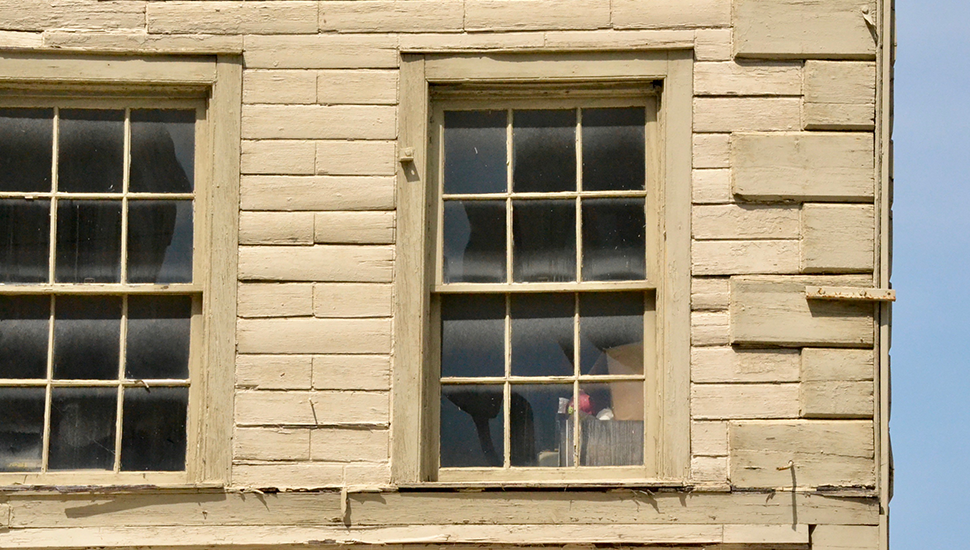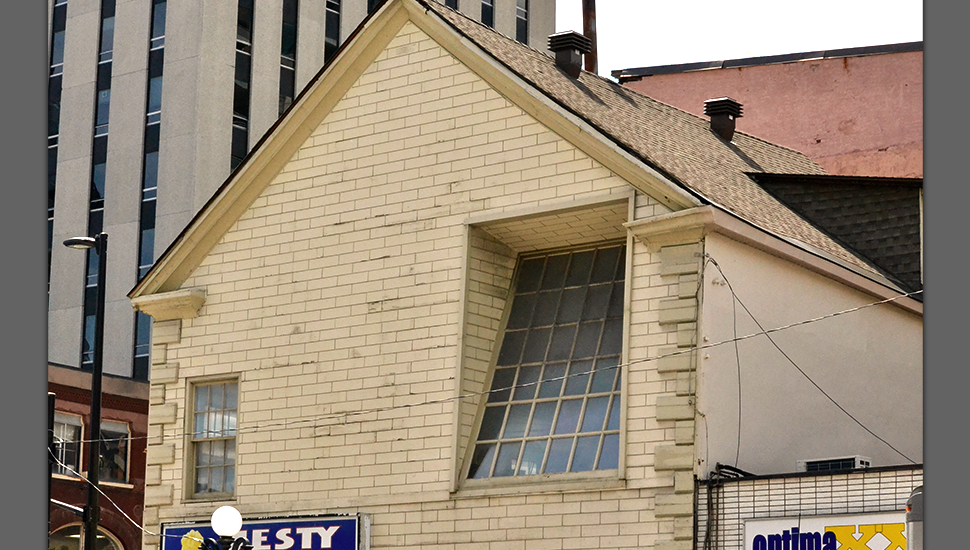22. Clegg-Feller Building | Windsor Smoke Shop
Construction: circa 1864
Architect: Unknown
Location: 155-159 Rideau Street, Ottawa
The Clegg-Feller Building is the oldest surviving example of commercial architecture in Ottawa, according to architect Julian Smith. The five-bay commercial block on the northwest corner of Dalhousie and Rideau streets was likely built on speculation in 1864 by William Clegg Junior (1820-1907), son of Captain William Thomas Clegg. A barrister by trade, William Clegg Junior had an office on the north side of Rideau Street and owned a number of properties in the area.
Built in the neo-Georgian style, this simple two-storey structure with attic and gable roof was framed in timber, with a single shed-roofed attic dormer is positioned in the rear slope. The building was clad in horizontal wood siding with recessed joints and vertical score marks to imitate coursed ashlar stone. Plain raised corner quoins were executed in timber.
The second floor of the front elevation remains largely intact, with five equally spaced 6/6 vertical sash windows.
A prominent feature of the Dalhousie Street elevation is the large, recessed window generally associated with art or photography studios. The 36-light sash is inclined inward at the top to capture more light. The gable end has a moulded raking cornice with eaves return.
The first tenants of the block were Mr. and Mrs George Bott, grocers, who occupied the corner store front and resided upstairs. By 1868 they were joined by Mrs. James (Catherine) Egleson, a dealer in ladies’ underclothes, who occupied the easterly Rideau Street store front. Both businesses closed in 1880, likely resulting from the world-wide depression of 1873-1879. They were succeeded by George J. Duff, a hatter and manufacturer of straw goods, and Wilfred Normand, the first of several tobacconists. Normand encountered financial difficulties and on March 29, 1886 all his household furniture and effects were put up for auction. George Duff gave up a share of his store to a jeweler in 1890 before eventually leaving in 1894.
Over the following years the Clegg-Feller Building had a number of notable tenants. The unique window on the east elevation is likely attributable to photographer William Charron, who had a studio on the second floor from 1911 to 1924.
The Ottawa & Hull House Furnishing Company temporarily occupied the building in 1916 until its larger store at 135-139 Rideau Street, which later became Caplan’s Department Store, was ready.
Percy Feller—who shares the building’s name with Clegg—acquired the property in 1947 and operated a Fashion Dress Shop from 155 Rideau Street.
In 1948, the Windsor Smoke Shop opened at the corner location at number 159, where it remained in business until 1994, becoming a landmark on Rideau Street.
The Clegg-Feller Building was designated by the City of Ottawa under Part IV of the Ontario Heritage Act on February 20,1980.
The Clegg-Feller Building came under threat after its long-time owners, the Feller family, sold the property to Paul Faynwachs, president of Gora’s Antiques Limited. In 1989, Faynwachs announced plans to demolish the structure in the spring of 1990, in order to build a six-storey office building.
Heritage Ottawa's president at that time, Richard Cannings, rallied public support for the historic building, noting that together with the Larocque Department Store (now Mercury Court) restored by architect Barry Padolsky on the opposite corner, the Windsor Smoke Shop building provided a natural gateway to the market.
“Heritage Ottawa will do everything in its power to save this irreplaceable building”, stated the organization in its Newsletter of January, 1990.
In spring 1991 it was announced that, with help of a grant from the City of Ottawa, the owner would hire architect Julian Smith and developer Eric Cohen of Cohen’s Architectural Heritage to restore the Clegg-Feller Building.
The Clegg-Feller Building continues to stand at the corner of Rideau and Dalhousie Streets, where it currently houses a Zesty Market.





